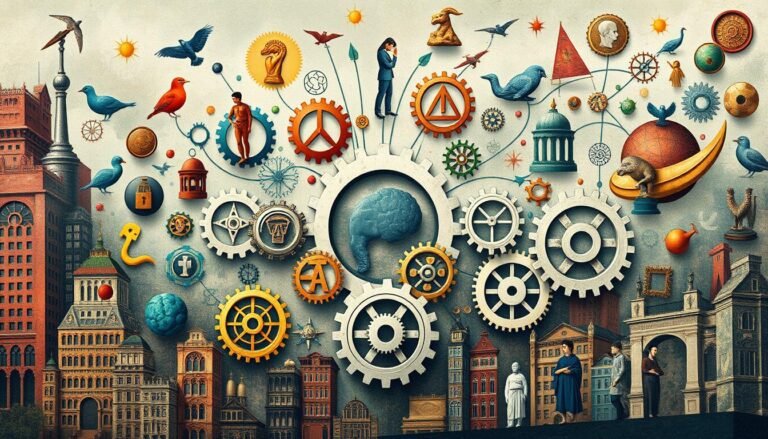Sociology of the Environment: Human Interaction with Nature
Have you ever thought about how our actions affect the world? Environmental sociology looks into how we connect with nature. It shows us our impact on the planet. This study makes us think about our role in nature.
Our environment is key to our well-being, from the air we breathe to the water we drink. But, our actions put a strain on these resources. For example, air pollution kills up to 60,000 Americans each year, and that’s just in the U.S. Worldwide, it’s a staggering 2 million lives lost annually.
This highlights the need to tackle environmental issues fast. Environmental sociology started in the late 1970s to address these concerns. It looks at how society affects the use of resources and how we deal with environmental problems.
Now, with climate change, deforestation, and pollution, environmental sociology’s insights are more crucial than ever. It helps us see how our actions and the environment affect each other. For instance, it looks at why people adopt renewable energy, how we manage waste, and sustainable tourism.
Key Takeaways
- Environmental sociology studies the interaction between societies and nature
- Air pollution causes millions of deaths globally each year
- The field challenges anthropocentric views of human-nature relationships
- It explores social factors in environmental resource management
- Environmental sociology aids in understanding climate change and pollution impacts
- The discipline examines sustainable practices in energy, waste, and tourism
Introduction to Environmental Sociology
Environmental sociology looks at how humans and nature interact. It started in the late 1970s, thanks to the 1960s’ environmental movement. It shows how social factors affect our ecological connections and environmental problems.
Definition and Scope
This field explores how people, technology, health, and social inequality affect the environment. It studies how our actions change nature and how nature changes society.
Historical Development
Environmental sociology has grown a lot over time. It used to focus mainly on using up resources and polluting. Now, it deals with big issues like climate change and losing species. In 2015, NASA found that Earth was the warmest ever recorded, showing how urgent these problems are.
Importance in Contemporary Society
Today, environmental sociology is key. It helps us grasp and solve big problems:
- Climate change impacts
- Water scarcity and pollution
- Biodiversity loss
- Environmental justice
A 2019 UN report said thousands of species could go extinct because of us. This field gives us the tools to face these issues. It’s essential for making sustainable policies and decisions.
| Environmental Issue | Social Impact | Sociological Perspective |
|---|---|---|
| Climate Change | Displacement, food insecurity | Inequality, adaptation strategies |
| Water Scarcity | Health issues, conflict | Resource management, social justice |
| Biodiversity Loss | Ecosystem disruption, economic losses | Human-nature relationships, conservation |
The New Ecological Paradigm (NEP)
The New Ecological Paradigm (NEP) is a big change in how we study the environment. It came about to challenge the old idea that humans don’t affect nature. Now, we see how closely linked our societies and nature are.
Challenging Human Exemptionalism
The NEP questions the belief that humans are not influenced by the environment. It argues that culture alone can’t beat nature’s limits. This new view has changed how we see our role in the world.
Core Principles of NEP
NEP is built on several key ideas:
- Humans are part of, not separate from, nature
- Environmental forces affect human affairs
- Earth has limited resources and carrying capacity
- Human actions have unforeseen consequences on ecosystems
Influence on Research
The NEP has changed environmental sociology research a lot. It led to more studies on how humans and nature interact and how people view the environment. The NEP Scale, created in 1978, measures people’s views on ecological issues. It’s used all over the world to understand environmental attitudes.
| NEP Scale Focus | Example Statement |
|---|---|
| Balance of Nature | “The balance of nature is delicate and easily upset” |
| Limits to Growth | “We are approaching the limit of people the Earth can support” |
| Human Domination | “Humans have the right to modify the natural environment” |
The NEP keeps influencing environmental sociology, promoting a deeper understanding of human-nature interactions. It encourages researchers to look into the complex relationships between ecology and society.
Human-Nature Relationships: Theoretical Perspectives
Environmental sociology offers many views on how humans and nature interact. These theories help us grasp environmental problems and find solutions. Let’s look at some main ideas that shape our view of human-nature relationships.
Existential dualism sees humans as part of nature but also separate because of our culture. This idea shows our special place in the world. Eco-Marxism looks at environmental issues through social and economic systems.
Ecological modernization theory believes economic growth and protecting the environment can go hand in hand. It suggests using technology and policy changes to make this possible. This view is more hopeful about how humans and nature interact.
“Nature connectedness is associated with mindfulness and overall well-being.”
Studies show being close to nature is good for our health and happiness. For example, forest bathing in Japan has shown positive effects on people. The NR-6, a short test, helps measure how connected we feel to nature.
| Theoretical Perspective | Key Focus | Approach to Environmental Issues |
|---|---|---|
| Existential Dualism | Human-nature duality | Balancing human needs with environmental preservation |
| Eco-Marxism | Socio-economic systems | Addressing environmental degradation through systemic change |
| Ecological Modernization | Technology and policy | Promoting sustainable development through innovation |
These views help us understand environmental challenges and guide us towards a sustainable future. By looking at different ideas, we can find better ways to solve complex environmental problems.
Environmental Issues as Social Constructs
Environmental issues are not just about the physical world but also about how we see them. They are shaped by many factors. Knowing these factors is key to solving environmental problems.
The Role of Media in Shaping Environmental Perceptions
Media greatly affects how people think about environmental issues. News stories, like those about the 2010 Haiti earthquake or the BP oil spill, change public views and actions. For example, the BP disaster made people worry more and ask for better rules.
Cultural Variations in Environmental Attitudes
People around the world have different views on the environment. This is clear in how communities react to environmental disasters. The 1984 Bhopal gas leak in India showed big differences in safety and environmental laws.
Power Dynamics in Environmental Discourse
Who has power shapes how we talk about the environment. After Hurricane Katrina in 2005, it was clear that poor decisions can cause big problems. These problems often hit the most vulnerable people hard.
| Environmental Event | Impact | Social Construct Revealed |
|---|---|---|
| Haiti Earthquake (2010) | 250,000+ deaths | Vulnerability of developing nations |
| BP Oil Spill (2010) | 200 million gallons leaked | Corporate responsibility in environmental protection |
| Bhopal Gas Leak (1984) | 3,000-16,000 immediate deaths | Industrial safety standards disparity |
| Hurricane Katrina (2005) | 1,800+ deaths, 700,000+ homeless | Social inequalities in disaster response |
Environmental sociologists say it’s important to understand these social ideas to tackle climate change and natural disasters. The study of this field is changing. It’s now looking at how society and nature interact, using new ideas like political ecology.
Sociology of the Environment: Human Interaction with Nature
Environmental sociology looks at how humans and nature interact. It shows how our social setup affects the environment and our actions towards nature. We need sociology to look beyond just human actions to fully understand environmental problems.
Environmental sociologists study how our social setup and cultural ways shape our relationship with nature. They use insights from ecology, geography, and environmental studies to understand human-nature connections.
Our view of nature is shaped by culture and power, says the social construction of nature idea. This idea questions the old idea of society and nature as separate things. It shows they are deeply connected.
“Merely adding the environment to sociological considerations perpetuates an anthropocentric worldview, reinforcing the divide between Society and Nature.”
Environmental sociology is key in shaping policies and governance. It looks at how society causes environmental problems. This helps create plans for sustainable growth that consider economy, society, and the environment.
| Key Aspects | Implications |
|---|---|
| Social structures | Shape environmental patterns |
| Cultural practices | Influence human-nature interactions |
| Power dynamics | Affect environmental discourse |
| Social movements | Drive environmental activism |
With more environmental challenges, environmental sociology’s insights are more important than ever. They help us see why environmental issues happen and guide us towards better practices and social setups.
Climate Change: A Sociological Perspective
Climate change affects more than just the environment; it impacts every part of society. Sociologists show how social factors drive global warming and shape our response. They reveal a complex network of social forces.
Social Factors Contributing to Climate Change
Economic systems are a big part of climate change. Big market players, mainly from developed countries, produce 60% of the greenhouse gases. The way we produce goods and services is also to blame for climate issues.
Societal Impacts of Global Warming
Global warming hits different societies in different ways. In some places, it seems to lessen environmental problems, but it often moves these issues to poorer areas. This shows we need to look at climate change globally to fight for justice.
Climate Justice and Equity Issues
Justice in the environment is key when talking about climate change. Global inequality makes it hard to work together on climate issues. It also breaks trust between countries. This makes fighting for climate justice harder.
| Theory | Contribution to Understanding |
|---|---|
| Treadmill of Production (TOP) | Evaluates market structure and organization |
| Ecological Modernization Theory (EMT) | Assesses policies and environmental outcomes |
| Combined TOP and EMT | Facilitates cross-comparative understanding at global level |
Understanding these views is key to fighting climate change and promoting justice worldwide.
Environmental Justice and Social Inequality
Environmental justice shows how environmental risks are not spread evenly in society. People with lower incomes and those of color often face the worst of these issues. This points out big problems with fairness and how resources are shared.
In Houston, a clear example of environmental racism was seen. Every city-owned landfill was in a black neighborhood, even though African Americans made up just 25% of the city’s people. This shows deep social inequalities.
Environmental disasters also highlight these unfairnesses. The 2010 BP oil spill poured 200 million gallons of oil into the ocean. The 1984 Bhopal accident, caused by a pesticide leak, killed thousands and injured half a million people. Both events hit vulnerable communities hard.
Natural disasters like Hurricane Katrina in 2005 also showed social unfairness. The storm killed over 1,800 people and left 700,000 homeless. Studies found African Americans and those with lower incomes faced worse flooding and had a hard time finding new homes.
| Environmental Issue | Impact on Marginalized Communities |
|---|---|
| Landfill Location | Disproportionately in minority neighborhoods |
| Industrial Accidents | Higher exposure and health risks |
| Natural Disasters | Greater vulnerability and slower recovery |
The environmental justice movement wants to fix these unfairnesses with policy changes and activism. It focuses on fairness and sharing resources better. The goal is to make environmental protection and community well-being more balanced.
Sustainable Development and Social Change
Sustainable living is now key in our world. As we face more environmental issues, communities are stepping up to help. They’re leading the way in saving our planet. This change needs social change and using eco-friendly tech.
Community Conservation Initiatives
Community conservation works well to protect nature. Small groups often start big changes and manage resources better. For instance, local groups have cleaned up watersheds and saved endangered animals by working together.
Eco-friendly Technologies
Using green tech is important for a sustainable future. Things like solar panels, electric cars, and smart homes are getting popular. They cut down on carbon emissions and use energy better. As costs go down and more people learn about them, more are choosing these green options.
Environmental Education
Teaching about the environment helps change behavior. Schools, community centers, and online offer programs to teach about nature. These programs teach how to live sustainably and make people feel responsible for the planet.
| Initiative | Impact |
|---|---|
| Community Gardens | Increased local food production, reduced carbon emissions |
| Recycling Programs | Decreased landfill waste, conservation of resources |
| Energy-Saving Campaigns | Reduced energy consumption, lower utility costs |
By working together, using new tech, and teaching, we can make big changes. These steps lead to a future that’s good for people and the planet.
Globalization and Environmental Challenges
Globalization has made global environmental issues more pressing. It has brought transnational corporations and international agreements into the spotlight. The world’s economy is now more connected than ever, leading to big environmental challenges that go beyond borders.
Transport-related CO2 emissions are set to increase by 16% by 2050, mainly because of more global trade. This shows we need to make international trade more sustainable fast.
Globalization has hit biodiversity hard. Since 1970, the number of organisms has dropped by 68%. Latin America and Africa have seen the biggest declines. This includes a drop in fish, reptiles, and amphibians, showing how global trade affects nature.
Big companies across borders are key players in the environment. They can affect many countries, making it hard to control their environmental impact. International agreements try to help, but putting them into action is tough.
| Region | Biodiversity Loss | Main Factors |
|---|---|---|
| Latin America | High | Deforestation, Agriculture |
| Africa | High | Resource Extraction, Climate Change |
| Asia | Moderate | Urbanization, Pollution |
| North America | Low to Moderate | Habitat Fragmentation, Invasive Species |
Sociologists are key in tackling these environmental issues. They look into how social structures and cultural habits affect our actions. They study how choices and policies impact the use of resources and the environment.
The Tragedy of the Commons: Sociological Insights
The idea of the “tragedy of the commons” is key in environmental sociology. It leads to debates on how we manage resources and work together. Garrett Hardin first brought it up, showing how shared resources can get used up when people only think about themselves.
Hardin’s Concept and Criticisms
Hardin believed that if many people can use the same resource, they will use too much and it will run out. Some say his idea is too simple and doesn’t see how communities can work together to protect resources.
Common Pool Resource Management
Elinor Ostrom changed the game with her work on the commons. She spent years studying and found that communities can take care of shared resources on their own, without needing the government to step in. In 2009, she won the Nobel Prize in Economics for her work on how to manage the environment.
Community-Based Environmental Solutions
There are many examples of communities working together to protect the environment. They often do a better job than big, top-down systems. This shows how important it is for people who use the resources to be involved in making decisions. It also highlights the need for flexible plans to tackle environmental issues.
| Approach | Key Features | Effectiveness |
|---|---|---|
| Top-down Governance | Centralized control, uniform policies | Mixed results, often inefficient |
| Community-Based Management | Local knowledge, adaptive strategies | Often more successful, context-specific |
| Hybrid Models | Combination of state and community efforts | Promising, balances different strengths |
The idea of the tragedy of the commons still shapes environmental policies and research. By knowing its good and bad points, we can make better ways to manage resources and protect the environment.
Future Directions in Environmental Sociology
Environmental sociology is changing fast to tackle new environmental problems. It has a global impact factor of 8.4, making it more popular in schools. Now, it looks at how humans affect global environmental change, showing we’re part of ecosystems.
Working together across different fields is vital for solving big environmental issues. Sociologists are teaming up with scientists, policy makers, and leaders in communities. This teamwork helps us understand how society and nature are connected. It leads to better ways to fix environmental problems.
Research in environmental sociology has big policy implications. As it grows, it will help shape policies for sustainable development and managing the environment. It sheds light on how people act towards the environment. This can guide policies that are good for the planet and people.
In the future, environmental sociology must keep up with a more connected world. Even though the U.S. and Europe have different ways of doing things, this variety helps the field grow. To really grasp environmental issues, we need to study them in various places around the world.
Source Links
- Environmental sociology: what it’s about and why it’s important |
- 20.3 Society and the Environment
- Human-Environmental Interaction: Definition | Vaia
- The Environment and Society
- Environmental Sociology | Introduction to Sociology
- Environmental sociology
- NewEcologicalParadigm(NEP)Scale_Anderson.indd
- New Ecological Paradigm in Environmental Sociology
- The Human–Nature Relationship and Its Impact on Health: A Critical Review
- 15.1 Sociological Perspectives on Population and the Environment
- 15.3 The Environment | Social Problems
- Environmental Sociology and the Second Darwinian Revolution
- Against the Environment. Problems in Society/Nature Relations
- Longdom Publishing SL | Open Access Journals
- Sociological Perspectives on Climate Change and Society: A Review
- Climate Change and Society: Sociological Perspectives
- 20.4 Understanding the Environment
- ASSESSING ENVIRONMENTAL INEQUALITY: HOW THE CONCLUSIONS WE DRAW VARY ACCORDING TO THE DEFINITIONS WE EMPLOY
- Sustainability through the Lens of Environmental Sociology: An Introduction
- Sociology for sustainability science – Discover Sustainability
- Effects of Globalization on the Environment
- Globalizing Environmental Sociology (Chapter 2) – The Cambridge Handbook of Environmental Sociology
- Environmental Sociology – Sociology
- The Tragedy of the Commons – The Decision Lab
- The Tragedy of the Commodity – Rutgers University Press
- Towards a global environmental sociology? Legacies, trends and future directions
- New directions and research trends in environmental sociology







